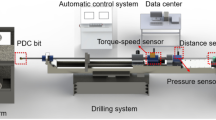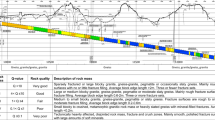Quantitative evaluation of rock drillability is of vital importance for selecting drilling bits and optimizing drilling parameters. The existing drillability evaluation methods are mostly designed for balanced and near-balanced drilling situation (roughly 0 bottomhole differential pressure), while investigations of under-balanced drilling are rare. In this work, rock drillability and acoustic velocity testing devices are used to investigate rock drillability in an under-balanced drilling situation. The experimental results showed that bottomhole differential pressure produces a great impact on both rock drillability and acoustic characteristics. Mathematical statistics methods have been applied to analyze the correlations between rock drillability and acoustic characteristics as well as between differential pressure and acoustic characteristics, and to build a model for forecasting rock drillability under various bottomhole differential pressures. The model provides a sound approach to quantitative assessment of rock drillability based on log data.



Similar content being viewed by others
References
Tinggen Chen and Zhichuan Guan. Drilling Engineering Theory and Technology. University of Petroleum Press. Dongying, China (2000), pp. 166–211.
Hongjing Yin. Practical Rock Drillability. University of Petroleum Press. Dongying, China (1989), pp. 20-120.
Houmei Zhang and Yougang Xue. Drilling & Production Technology, China. 22 (1), pp. 10–13 (1999).
Shibin Li and Chi Ai. Journal of Daqing Petroleum Institute, China. 23 (3), pp. 89–90 (1999).
E. C. Oniya— In: SPE Annual Technical Conference and Exhibition, Houston, Texas, October 1988. SPE 18166.
Shibin Li, Tie Yan, and Yiwei Zhang. Journal of Daqing Petroleum Institute, China. 26 (3), pp. 26–28.
Deyong Zou and Yonghong Chen. Oil Drilling & Production Technology, China. 18 (6), 27–30 (1996).
Yishan Lou, Enqiang Chen, and Houmei Zhang. Drilling & Production Technology, China, 20 (3), pp. 14–17 (1997).
Jin Yang and Gao Deli. Drilling & Production Technology, China. 21 (2), pp. 1–3 (1998).
K. L. Mason. SPE Drilling Engineering, pp. 135–142 (1987). SPE–13256.
J. R. Sparr, L. W. Ledgerwood, R. L. Graff, et al. In: SPE/IADC Drilling Conference, Amsterdam, Netherlands, February–March 1995. — SPE/IADC 29397.
Author information
Authors and Affiliations
Corresponding author
Additional information
Translated from Khimiya i Tekhnologiya Topliv i Masel, No. 3, pp. 46 – 49, May – June, 2016.
Rights and permissions
About this article
Cite this article
Hui, Z., Tengfei, S., He, H. et al. Experimental Investigation of Formation Rock Drillability Under Bottomhole Differential Pressure Conditions. Chem Technol Fuels Oils 52, 310–317 (2016). https://doi.org/10.1007/s10553-016-0709-y
Published:
Issue Date:
DOI: https://doi.org/10.1007/s10553-016-0709-y




